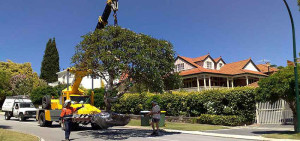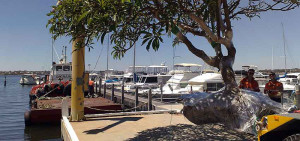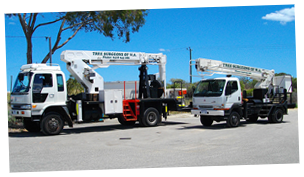There are many reasons why you may want to transplant a tree in Perth. For example, you could be building a new home or carrying out renovations that require the removal of some landscaping features such as mature shrubs and trees. Alternatively, your foliage might have simply outgrown its space and may be obscuring light or posing a risk to your property or other nearby structures.
Whatever the reason, the fact remains that there are some risks involved with relocating a tree in Perth. Trees aren’t really designed to be moved, and after relocation many plants go through something that is known as transplant shock.
Thankfully, there are a number of things you can do to mitigate this risk and ensure your plant is happy and healthy in its new home. With close to 40 years of experience in the arboriculture industry, Tree Surgeons of WA have the experience and specialist equipment to ensure your tree is transplanted safely and effectively.
In this article we’ve rounded up all the information you’ll need to minimise the effects of transplant shock.
What is Tree Transplant Shock?
 While we always take the utmost care to preserve the health of your tree during relocation, the process can be a little stressful for some types of trees. This stress can affect the plant’s ability to establish strong roots, which in turn may impact its leaf growth, vulnerability to insects and diseases, and overall health.
While we always take the utmost care to preserve the health of your tree during relocation, the process can be a little stressful for some types of trees. This stress can affect the plant’s ability to establish strong roots, which in turn may impact its leaf growth, vulnerability to insects and diseases, and overall health.
There are a few different symptoms that indicate your tree might be suffering from transplant shock. One of the most common signs is that its leaves may wilt, change in colour and – if preventative measures are not taken – even drop off. Leaves can also change shape and curl in slightly around the edges.
Here at Tree Surgeons of WA, we’re well versed in the risks of transplant shock and have developed a very careful strategy that maximises the chances of a successful relocation. After we’ve transplanted your tree, you can help speed up the plant’s rehabilitation by:
Feeding it Some Sugar
A spoonful of sugar doesn’t just help the medicine go down – it can also help your tree recover after transplant. Research published in the Journal of Arboriculture found that regularly applying a solution of sugar and water to the roots of a transplanted tree could play a role in managing transplant shock. Investigators noted that the sugary solution improved root and shoot growth, while reducing the risk of transplant loss. This method has only been proven to work some species of plants but it’s still worth a shot!
Giving it a Trim
 In some cases, you may be able to minimise transplant shock by trimming back the plant’s foliage. This can potentially help because it allows your tree to focus on repairing and establishing its roots rather than channelling that energy into sustaining its branches and leaves.
In some cases, you may be able to minimise transplant shock by trimming back the plant’s foliage. This can potentially help because it allows your tree to focus on repairing and establishing its roots rather than channelling that energy into sustaining its branches and leaves.
It’s important to keep in mind that foliage does still play a key role in the wider health of your tree, so be conservative with your trimming in order to avoid disturbing the equilibrium. If you’re in any doubt whatsoever, enlist the services of a professional Perth arborist who will be able to give your tree a good trim without endangering its health.
Watering it Regularly
Most established trees are fairly independent when it comes to hydration, but newly transplanted plants may need a bit of a helping hand to deal with the shock.
With this in mind, be careful to regularly and thoroughly water your plant. Pay special attention to the roots – you want to aim to keep the roots moist while ensuring that the plant has good drainage and is not drowning in water. Anti-transpiration sprays may also be effective at helping your tree retain water, but avoid using these in the long term as they may affect the plant’s natural processes.
Being Careful Around the Soil
After transplanting your new tree, you may be tempted to even out the surrounding dislodged soil by stomping on it – don’t! Applying this sort of pressure can compact the soil, making it substantially more difficult for water, fertiliser and other applicants you may use to find its way to the tree’s roots.
You’ll also want to be mindful of the dryness of the soil around the roots. Try to prevent it from becoming excessively dry, as is quite common in the hot Perth summers, but also avoid overwatering it as this can be just as detrimental to the recovery process. A tensiometer is a relatively inexpensive tool that provides a foolproof way of knowing whether the soil surrounding the tree is excessively wet.
Being Patient
In much the same way you wouldn’t expect a friend or family member to be back on their feet straight after a transplant procedure, you need to be patient with your tree after its relocation. Even if your tree is looking quite sickly after being moved, it’s highly likely that it simply needs a few days to get over its transplant and adapt to its new surroundings. Give it some time to recover, continue caring for it and in no time at all your tree will be back to its beautiful, healthy self!
Transplanting a tree is a risky procedure, but you can rest assured that your precious flora is in the most capable of hands when you enlist the services of Tree Surgeons of WA. Drawing on decades of experience in the Perth tree care and garden maintenance industry, we use a tried and tested strategy that maximises the chances of a successful and stress free tree transplant.
If you’re thinking about removing or relocating a tree in Perth, we’d love to hear from you. Our friendly, expert team are ready and waiting to discuss your garden maintenance needs and can help your assess whether a transplant is a feasible option for you. Give us a call today for a no-obligation consultation.

